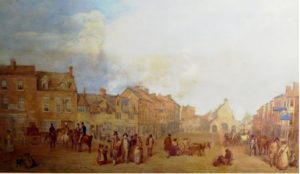Newport High Street in 1838 by Henry Ziegler

We have Caroline Davies of Davies, White & Perry to thank for preserving a wonderful watercolour of Newport High Street painted in 1838. It is fortunate that, not long after the painting was completed, a local person identified several of the characters and trades shown. The view is looking northwards towards the church.
The painting is by Henry Bryan Ziegler (1798–1874). He was a British artist, known as a landscape and portrait painter. He studied under John Varley, honed his skills at the Royal Academy schools, and eventually became a Royal Academician. He made a reputation as drawing master to members of the royal family; Queen Adelaide took him under her wing, and his views of Windsor castle are in The Royal Collections. Having relatives in Ludlow, he did several illustrations of Ludlow Castle and Shropshire towns.
Let us look at some of the details:

In the background you can see St Nicholas’ church, in front of it a small classical type of building – the butter market, commonly called ‘The Butter Cross’, and to the right of this the old William Adam’s town hall. Both the Butter Cross and the old town hall were demolished c.1858-60, when the new town hall was built.

On the left we can see the post office. The postmaster is identified as Mr Henry P Silvester, and he is shown at his front door. In front of the post office is the mail cart. This building eventually became printers Bennion & Horne/ The Advertiser, then Browns Motors. The next property is the Old Bell Inn.

To the right are Mr & Mrs Hughes, carriers, who we are told put up their donkey cart at the Star Inn; now Barbers estate agents. Their donkeys were called Molly and Ned.

The next feature to the right is what is described as ‘the Aqualate Chariot’. Here we see members of the Boughey family coming into town. It is likely that pictured are Thomas Fenton Fletcher Boughey and his wife Louisa (nee Giffard).

In the centre we have the town crier or ‘bellman’. He is identified as Mr Simpson. William Picken, a local Victorian antiquarian, described his uniform: the blue frock coat and the arms of the town (three fishes) embossed on a brass plate fastened on the right sleeve, a scarlet waistcoat, black velvet breeches, drab cloth leggings, and a black silk hat with a gold band round it. Next to Mr Simpson is a Mr Hutchinson. Behind Mr Simpson, sitting, is Mr Patrick identified as ‘a noted gingerbread manufacturer’ with his stall of sweetmeats

The ‘letter carriers ‘- the posties of their day- are shown bottom left. It is interesting to see that there were both male and female posties.
Here you can compare the west side of the street with Then and Now images. From the left :
Part of The Old Bell Inn – you can still see today the bell shapes on the dormer windows.
Then No 27-31 All were demolished in 1845 to make way for a terrace of three properties Now Clarks and Nationwide.
Then a two bay property – Now Head Quarters.
Then a four bay property – Now Evenett & Bishop and Newport Pizza.
Then a two bay property – Now Happy Smiles and The Glasshouse.
Beyond this, the old Crown Inn – now Davies, White and Perry. The red animal on a portico or pole standing out further along, marks the Red Lion Inn, which eventually became Barclays Bank; even today it still has the large inn yard at the back.


